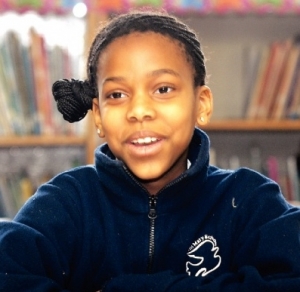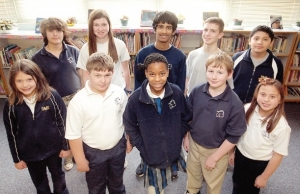St. Mary crowns geography champ
By Phyllis Moore
Published in News on January 21, 2011 1:46 PM

News-Argus/MICHAEL K. DAKOTA
Champion Imani Danieli earned the right to move on to the next phase of the competition.

News-Argus/MICHAEL K. DAKOTA
St. Mary School students grade-level finalists in the recent National Geographic Bee, front row from left, Emma Corpstein, Kenneth Wiggins, Imani Danieli, Jamie Lamont and Maddie Agner. Back row, Emily Flynn, Cameron Dove, Hari Chittilla, Matthew Kierski and Brandon Miranda. Fifth-grader Imani was the schoolwide winner.
A fifth-grader at St. Mary School emerged as the winner of the schoolwide National Geographic Bee recently and will advance to the next level of competition, a written exam to determine state competitors.
Imani Danieli said she prepared by going online and studying sample questions.
The actual contest at the school, though, followed qualifying classroom bees for 105 students in fourth through eighth grade. Two winners were named from each grade level, with 10 students taking part in the schoolwide event.
"It took about 45 minutes," said Kristy Gross, a seventh- and eighth-grade teacher at the school and organizer of the bee for the past two years. "It got down to 10, from 10 to 2, then the final between Imani and Hari (Chittilla, an eighth-grader)."
"I was nervous a little bit because like, there's harder questions than I'm normally used to," Imani said. "Especially the championship round, as the last two people were up and the person that got it right won out of three questions that were being asked."
Emily Flynn, one of the sixth-grade winners, had been eliminated by that point but offered her own observations.
"There were a couple of kind of trick questions, like they had one of the next to the last questions (about a river)," she said. "It sounded like it was from Taiwan. I think Hari said Taiwan but it was really China."
"It sounded like something oriental, I guess, so I just used that to realize that it was that part of the world," said Hari.
The answer was incorrect and Imani advanced as schoolwide winner, leaving Hari to contemplate a different strategy for the future.
"If you know more countries but you don't know more about them, then you might be in trouble," he said.
Not everyone who participated call history their favorite school subject. But Imani admitted social studies and science are hers.
"It's one of my favorites," Hari said. "Learning about different cultures and societies."
The bigger problem, he pointed out, is the time constraint involved.
"You have like 15 seconds to answer every question," he said. "You can only have a choice of hearing it more than once."
The contest is divided into both oral and written portions, the students said.
Matthew Kierski and Jamie Lamont, seventh-grade and sixth-grade winners respectively, were the only finalists who had previously competed in the event.
"The questions were about the same," Matt said.
"They were the same," Jamie replied. "Well, not the same but the same hardness."
The experience was beneficial, though, as Matt said he felt more confident going into the competition for the second year.
Having never been in it before, Kenneth Wiggins, fifth-grade finalist, said, "It was pretty cool, just being up in front of people, answering questions."
"Even though it's my second time, I was still scared," Jamie said.
"I feel like the people, all the spectators, don't cause it to be nerve-wracking," said Hari. "It was the 15 seconds (time limit)."
The youngest participants, fourth-grade finalists Emma Corpstein and Maddie Agner, may have been new to the tradition, but agreed that it was a worthwhile effort.
"It helps you learn for the test because there were harder questions than there actually are on the test," Maddie said.
"I thought it was a good experience," added Brandon Miranda, a seventh-grade finalist new to the school this year.
And while some advance preparation is helpful, most of the students said the biggest part is paying attention in class and throughout the school year.
"I didn't study for it," said Cameron Dove, an eighth-grade finalist. "You just kind of like do your best."
"I think it's something, the questions are not something you can learn overnight," Hari said. "It's things that are constantly emphasized in class."
For Imani, though, the secret to coming out on top is simple.
"I think that studying is good and just having enough courage -- be confident, don't give up on yourself," she said.
Vivian Snyder also qualified as a finalist for sixth-grade, Mrs. Gross said, but was absent on the day of the finals and Jamie Lamont stepped in and advanced for the grade level.
The next step for Imani, who received a medal and certificate, is a written test to determine state competitors. All school winners are eligible to win the national championship and its first prize, a $25,000 college scholarship, at the national competition in Washington, D.C., in May.
This is the 23rd year for the national bee and Lynn Magoon, principal at St. Mary, said it has been held at the school for most of her 21 years there.
